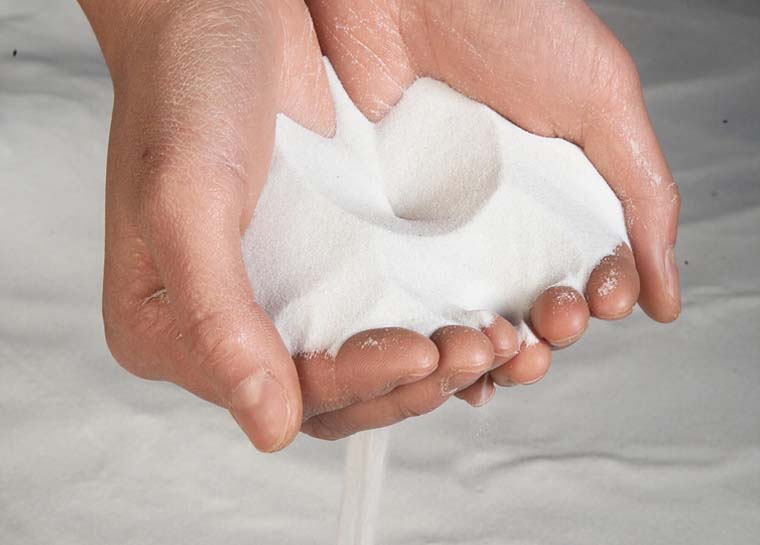Silica or silicon oxide with the chemical formula SiO2 is the most abundant oxide compound in the Earth’s crust. Silica is present in nature in free form or in combination with other oxides. In general, the uses of silica are:
Glassmaking, porcelain, ferrosilicon production, ceramics, lime sand brick production, casting, sodium silicate production, production of other silica materials, as a semiconductor in the electronics industry and glass wool production. Significant amounts of crushed sandstone are used as building materials.
The silica used in each of these industries must have a certain quality.The chemical composition, mineralogical structure and physical properties of silica determine its quality and uses in each of these industries. The chemical composition of silica is actually the percentage of SiO2 in the rock as well as the percentage of each of the other oxides that are usually present with SiO2 in various deposits. If the percentage of each of them exceeds a certain limit, its use in various industries will be limited or impossible.
In addition to the percentage of SiO2, the mineralogical structure of the rock also plays an important role in determining its quality and uses, because SiO2 may be present in the form of various silicates, so this issue will determine the mineralization method and how to remove impurities. The physical properties of silica will also be affected in the same way suitable for crushing, granulating the produced silica powder and determining the uses of the produced powder.
Application of silica in industries
Enameling: Silica is a constituent of glass, it is combined with materials such as feldspar, nepheline syenite, soda, etc. to make different types of silica glass.
Ceramics: Quartz is used in the manufacture of various types of ceramics and sanitary ware.
Casting and Refractory: The resistance of quartz and silica to a temperature of 1470 C has led to its use in the manufacture of metal castings such as steel, ferrous iron, aluminum and copper alloys, as well as as refractories in the manufacture of iron and steel, ceramic, glass and cement furnaces. Other miscellaneous applications include abrasives, polishing powder, filtration, construction sand. Round and quality types are used to open gaps and increase permeability in oil and gas production. Also, by pulverizing it, it can be used as a filler in paint, plastic, rubber, putty and glue.
Types of Silica
Sodium Silicate: Sodium silicate is sold in the form of clear pellets, without water and glass powder or aqueous powder. This material is used in controlling the abrasion of water pipes and the formulation of glaze and enamel. Its various liquid solutions are used in soap making, industrial and general cleaners, adhesives, cementing, paints and coatings, casting molds, ore flotation, peroxide stabilization and corrosion control in water pipes and zeolite-mixed silica precursors.
Sedimented Silica: Sodium silicate reacts with sulfuric acid or hydrochloric acid to produce precipitated silica under certain conditions, due to its high luminosity and low porosity as a fine-grained and non-slip filler in tires (car tires and PVC flooring, poly Olefin, LDPE film and microporous separators for lead batteries, diffusers, carriers and many more are used.
Colloidal Silica: A suspension of fine-grained silica in aqueous medium used for friction on paper and boards, fiberglass refractories, catalysts and chemical precursors.
Silica, Type of Metallurgy: It is made from the reaction of quartz and coke in an electric arc furnace at a high temperature of C’2000 and has 99-98% Si. There are other types of silica and its compounds such as baked silica, silicon chips, silicon nitrate, etc., each of which has its own applications.
Crystal Quartz: Transparent and pleasant types are used for making lenses and cones, jewelry and mineral samples, using its piezoelectric property in electronics.
Triple Silica: Micro-crystalline silica, porous with a specific gravity of 2.65, hardness 7, white to gray, etc., which is used as a filler or pigment in paints, rubber, plastics, abrasives and putties. In addition, it is used in abrasive and polishing powders.
Novacolite Silica: White to gray porous stone, light brown to black, made of dense amorphous quartz grains with excellent abrasive properties: cleaning metals, grinder, refractory and lightweight building materials.
Flint Silica: Hidden chalcedony silica dense crystal (ceramic, bone china, grinder, etc.)
Classification of Silica Types Based on SiO2 Percentage and Consumption:
Grade I
This type of silica has at least 96% SiO2 and is used in glass, glaze, chemical industry, ferrosilicon, fiberglass, sodium silicate, ferrochrome and cement sand test.
Grade II
This type of silica has 85-95% SiO2 and is used in casting sand, sandblast sand, filtration and refractories.
Grade III
This type of silica has 70-85% SiO2 and is used in calcareous sand brick and light brick, cement and light concrete factories.

